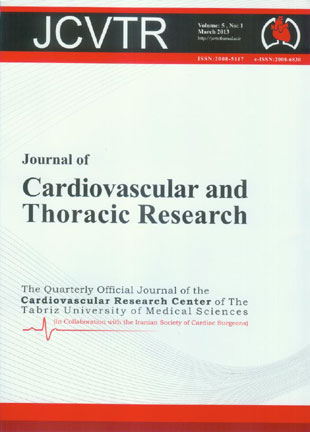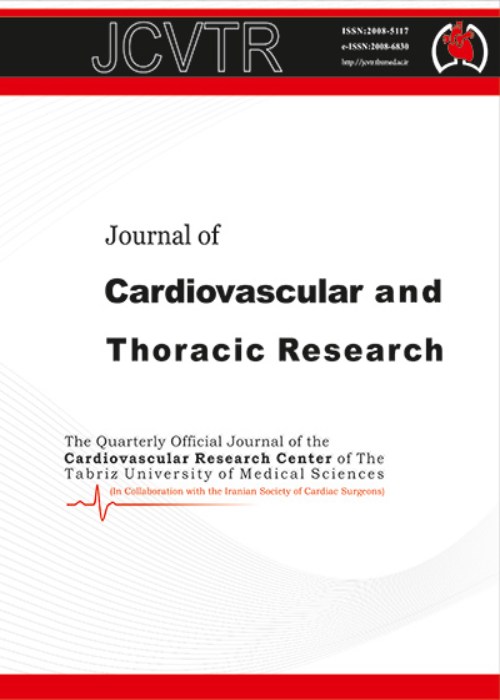فهرست مطالب

Journal of Cardiovascular and Thoracic Research
Volume:5 Issue: 1, Mar 2013
- تاریخ انتشار: 1391/10/20
- تعداد عناوین: 7
-
-
Pages 1-4IntroductionLimited information is available regarding the relationship between coronary vessel dominance and atherosclerotic involvement. Rheological factors have been implicated in the pathogenesis of coronary lesions. More than 90% of the coronary blood flow enters the left coronary if it is the dominant artery. The main purpose of this study was to determine the relation between left coronary dominance and atherosclerotic involvement of left anterior descending artery (LAD) origin. In addition, the prevalence and degree of associated ischemic mitral regurgitation (MR) in these patients were assessed.MethodsThe study included 678 consecutive patients with an indication for coronary angiography. One hundred and twenty two patients with right dominant and 61 patients with left dominant arteries were randomly selected for analysis. All demographics, risk factors, coronary dominancy and involvement, left ventricular ejection fraction (LVEF), and MR were recorded.ResultsOne hundred and eighty three patients (mean age of 57.7 years) were studied. The types of coronary circulation included right, left, and balanced in 78.6%, 8.9%, and 12.5%, of the patients respectively. In 64 patient with significant LAD lesions, 22 (34.9%) had ostial while the remainder had non-ostial involvement. Ischemic MR was present in 5 (2.7%) patients. There was no difference in demographics, risk factors, LVEF, MR, extent of coronary artery disease, and LAD ostial involvement between left and right dominant circulations.ConclusionIn this study, left coronary dominance was not associated with atherosclerotic involvement of LAD ostium and ischemic MR.Keywords: Coronary Artery Disease Coronary Artery Dominance Angiography
-
Pages 5-9IntroductionCongenital heart diseases are of immense importance and also a high prevalence. Contributing factors to developing these defects have not been abundantly studied. Therefore, the current study was conducted aiming at determining the effective factors on Congenital Heart Disease (CHD) in newborn infants of Northwest Iran.MethodsA case-control study was carried out in North-West of Iran from 2002 to 2012 and a total of 473 infants entered the study. Required data were obtained through check lists completed by the information of hospital records and interview with mothers of 267 newborn infants with CHD together with medical records of mothers as the case group, and 206 medical records of healthy infants at the same period all together with those of their mothers as the control group. The obtained data were statistically analyzed using descriptive statistical methods, T-test, Spearman’s correlation coefficient, and Multi-variable Logistic Regression Model (OR with 95% CI), using SPSS.19. In the present study, P value less than 0.05 was considered statistically significant.ResultsBased on the results of univariable analyses, the number of previous cesarean sections, past medical history of diseases, gestational age (GA), fetal weight at birth, diastolic blood pressure, fetal heart rate, pulse rate, fetal hemoglobin and hematocrit levels, and fetal head circumference at birth have significant relationship with incidence of congenital abnormalities (P<0.05). Family history, past cesarean sections history, past medical history and GA had significant relationship with CHD incidence.ConclusionBased on the results of present study, in order to control and reduce the cases of CHD, it is crucial to make proper decisions and implement policies for reducing cesarean cases, lowering consanguineous marriages, providing proper pre-marriage counseling, prompt treatment of mothers’ illnesses, improving pregnancy health care and mothers’ health status for the purpose of better well-being of newborn infants.Keywords: Congenital Heart Disease Risk Factors Newborn Infants Iran
-
Pages 11-16IntroductionPostoperative stenosis and dysphagia after esophageal carcinoma resection is the major problem. The aim of this study is to compare two types cervical esophagogastric anastomosis in reduction of stricture formation in esophageal cancer surgery.MethodsThe subjects of this study were 223 patients undergoing esophageal carcinoma resection during 1998 to 2007. Twenty two patients were excluded from the study because of recurrent malignancy of anastomosis, mortality and losing in follow up period. Two hundred and one patients remained by the end of study were classified into two groups: 98 patients were treated by routinely transverse hand-sewn cervical esophagogastric anastomosis (group 1); and 103 patients were treated by the proposed oblique hand-sewn esophagogastric anastomotic technique (group 2). All the operations were with high abdominal and left cervical incisions (Transhiatal esophagectomy). All patients of both groups were followed up at least 6-month for detection of anastomotic strictures.ResultsPostoperative dysphagia occurred in 20 patients of group 1 versus 5 patients of group 2. In working up by rigid esophagoscopy, two patients of group 2 and four patients of group 1 had not true strictures. Anastomotic strictures occurred in 16 cases of group 1, versus 3 cases of group 2. Statistical comparative analysis results of two groups about stricture formation were significant (3% versus 16% P= 0.003).ConclusionThe oblique hand-sewn esophagogastric anastomostic techniques reduce markedly the rate of stricture formation after esophagectomy.Keywords: Esophagus Carcinoma Esophagectomy Anastomotic Stricture
-
Pages 17-21IntroductionLaryngeal Mask Airway (LMA) has gained wide acceptance for routine airway management and with increasing emphasis on day care surgery it is widely used. The aim of this study was to assess the effects of mini dose succinylcholine (0.1mg/kg) with semi-inflated cuff on facilitation of laryngeal mask airway insertion in order to achieve more satisfaction yet less complications.MethodsIn a randomized double-blinded study, sixty ASA 1, 2 and 3 patients aged 20-60 years scheduled for urologic surgical procedures were included. Thirty patients received succinylcholine (Group S), and thirty received 0.9% sodium choride as a placebo (Group C).ResultsCoughing occured in 33.3% of patients in the control group and there was no incidence in succ group (P=0.002). Head or limb movement occurred in 70% of the patients in the control group vs. 10% in succ group (P<0.001). Laryngospasm occurred in 36.6 % of the patients in the control group but there was no incidence in succ group (P=0.004). Additional propofol was required in 53% of the patients in control group vs. 10% for succ group (P=0.001). Ease of insertion and first successfull attempt of LMA were achieved in 93.3% and 90% of the patients respectively in group S (P<0.05). Myalgia and sore throat occurred in 66.7 % of patients in the group C in comparison with 33.3% in group S (P=0.06).ConclusionThe combination of propofol with mini dose succinylcholine, provided a significantly better method for LMA insertion, while reduced propofol doses were needed and number of attempts decreased.Keywords: Laryngeal Mask Airway Succinylcholine Facilitation Propofol
-
Developing Indicators of Service Quality Provided for Cardiovascular Patients Hospitalized in Cardiac Care UnitPages 29-33IntroductionCardiovascular diseases are among the most prevalent chronic diseases leading to high degrees of mortality and morbidity worldwide and in Iran. The aim of the current study was to determine and develop appropriate indicators for evaluating provided service quality for cardiovascular patients admitted to Cardiac Care Units (CCU) in Iran.MethodsIn order to determine the indicators for evaluating provided service quality, a four-stage process including reviewing systematic review articles in premier bibliographic databases, interview, performing two rounds of Delphi technique, and holding experts panel by attendance of experts in different fields was adopted. Finally, after recognizing relevant indicators in resources, these indicators were finalized during various stages using ideas of 27 experts in different fields.ResultsAmong 2800 found articles in the text reviewing phase, 21 articles, which had completely mentioned relevant indicators, were studied and 48 related indicators were extracted. After two interviews with a cardiologist and an epidemiologist, 32 items of the indicators were omitted and replaced by 27 indicators coping with the conditions of Iranian hospitals. Finally, 43 indicators were added into the Delphi phase and after 2 rounds of Delphi with 18 specialists, 7 cases were excluded due to their low scores of applicability. In the experts’ panel stage, 6 items were also omitted and 10 new indicators were developed to replace them. Eventually, 40 indicators were finalized.ConclusionIn this study, some proper indicators for evaluating provided service quality for CCU admissions in Iran were determined. Considering the informative richness of these indicators, they can be used by managers, policy makers, health service providers, and also insurance agencies in order to improve the quality of services, decisions, and policies.Keywords: Indicator Service Quality Cardiac Care Unit Cardiovascular Diseases Delphi Technique
-
Pages 35-36The combination of congenital left ventricular aneurysm associated with mitral insufficiency is rare. We describe the case of a girl aged 11 years, bearing these two entities simultaneously. Aneurysmal resection of the left ventricle was performed with Dor technic to allow remodelation of the anatomy of the left ventricle. Mitral annuloplasty was performed through a transseptal approach. Three months after surgery, the child presents a good myocardial contractility without mitral regurgitation and normal ejection fraction.Keywords: Congenital Aneurysm Mitral Insufficiency Children
-
Pages 37-39CABG is one of the most common cardiac surgeries all over the world. Similar to other surgeries, it may be associated with some undesirable complications including neurologic complications which might cause morbidity and mortality after surgery. We will describe a case of Progressive Paraparesis after CABG Surgery and review its etiology, diagnosis and managementKeywords: Paraparesis CABG


